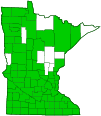prairie blue-eyed grass
(Sisyrinchium campestre)
Conservation • Description • Habitat • Ecology • Use • Distribution • Taxonomy
|
|
|||||||||||||
Description |
Prairie blue-eyed grass is an erect, 4″ to 16″ tall, perennial forb that rises in a tuft of 2 to 6 basal leaves and one or more flowering stalks from coarse, fibrous roots. The basal leaves are pale green, linear, flat, 3″ to 10″ long, and 1 ⁄32″ to ⅛″ wide. They are sharply pointed at the tip and are usually hairless. The stem is light green to olive green and may be slightly covered with a whitish waxy substance (glaucous). It is unbranched, distinctly winged, and no more than ⅛″wide. The inflorescence is a solitary flower or a single, unstalked, flattened, fan-shaped cluster (cyme) of 2 to 11 flowers at the end of the stem. The cyme is subtended and partially enclosed by a pair of claw-like bracts (spathes). The spathe is ½″ to 2 3 ⁄16″ long, green, and not at all or only slightly tinged purple. The outer bract is 1½ to 2 times longer than the inner bract. The margins are thin, membranous, and translucent or transparent. The margin of the outer bract is distinct all the way to the base. The flowers are ½″ to 1″ wide. They are borne on thin, thread-like stalks that are about as long as the spathes. They are drooping when in bud, becoming erect when in flower. Each flower has 3 petals, 3 petal-like sepals (6 tepals), 3 stamens, and 3 styles. The tepals are spreading, inversely lance-shaped, and ¼″ to ½″ long. They are rounded to notched at the tip with a bristle-like extension at the tip. They are usually pale violet or light blue, sometimes white, and they are yellow at the base. The stamens have white filaments and yellow anthers. The filaments are fused for most of their length around the styles. The styles extend beyond the anthers. The fruit is an egg-shaped, ⅛″ to 3 ⁄16″ long, light to dark brown capsule with many seeds. |
Height |
4″ to 16″ |
Flower Color |
Pale violet, light blue, or white |
Similar Species |
Strict blue-eyed grass (Sisyrinchium montanum var. montanum) flowers are usually dark bluish violet. The margins of the outer spathe bract are fused for 1⁄32″ to ⅛″ (1.0 to 3.5 mm) at the base. Narrow-leaved blue-eyed-grass (Sisyrinchium angustifolium) leaves and stems are not glaucous. There may be 2 to 4 stalked flower clusters on the stem, causing the stem to appear branched. |
Habitat |
|
Ecology |
Flowering |
May to July |
Pests and Diseases |
|
Use |
|
Distribution |
||
|
Sources |
|
| 5/29/2024 | ||
Nativity |
||
Native |
||
Occurrence |
||
Common |
||
Taxonomy |
|
Kingdom |
|
Division |
Tracheophyta (Vascular Plants) |
Subdivision |
Spermatophytina (Seed Plants) |
Class |
Liliopsida (Monocots) |
Order |
Asparagales (Agaves, Orchids, Irises, and Allies) |
Family |
Iridaceae (irises and allies) |
Subfamily |
Iridoideae |
Tribe |
Sisyrinchieae |
Genus |
|
Section |
Sisyrinchium |
Subordinate Taxa |
|
|
|
Synonyms |
|
Sisyrinchium campestre var. kansanum Sisyrinchium flaviflorum Sisyrinchium kansanum |
|
Common Names |
|
prairie blue-eyed grass |
|
Glossary
Cyme
A branched, flat-topped or convex flower cluster in which the terminal flower opens first and the outermost flowers open last.
Filament
On plants: The thread-like stalk of a stamen which supports the anther. On Lepidoptera: One of a pair of long, thin, fleshy extensions extending from the thorax, and sometimes also from the abdomen, of a caterpillar.
Glaucous
Pale green or bluish gray due to a whitish, powdery or waxy film, as on a plum or a grape.
Linear
Long, straight, and narrow, with more or less parallel sides, like a blade of grass.
Spathe
One or two large bracts that subtend, hood, or sometimes envelope a flower or flower cluster, as with a Jack-in-the-Pulpit.
Tepal
Refers to both the petals and the sepals of a flower when they are similar in appearance and difficult to tell apart. Tepals are common in lilies and tulips.
Wing
A thin, flat, membranous, usually transparent appendage on the margin of a structure.
What’s in a Name?
Contrary to its common name, prairie blue-eyed grass is an iris, not a grass.
Visitor Photos |
||
Share your photo of this plant. |
||
This button not working for you? |
||
Nancy Falkum |
||
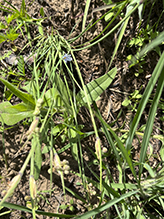 |
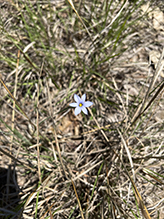 |
|
| Blue-eyed Grass at TNC Cox Unit |
|
|
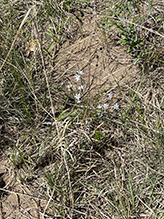 |
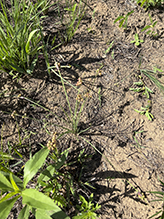 |
|
Blue-eyed Grass at TNC Cox Unit |
Blue-eyed Grass in bud at TNC Cox Unit | |
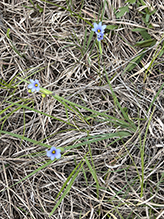 |
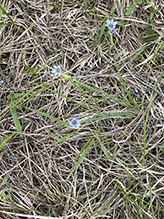 |
|
Blue-Eye Grass |
||
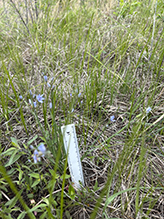 |
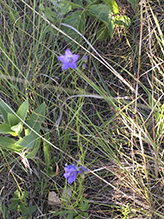 |
|
| Blue-Eye Grass |
|
|
Bill Reynolds |
||
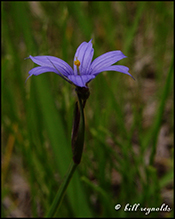 |
|
|
MinnesotaSeasons.com Photos |
||
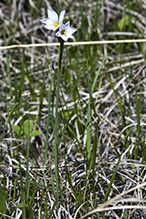 |
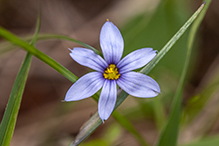 |
|
Flower |
||
| Plant | ||
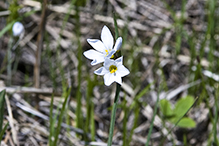 |
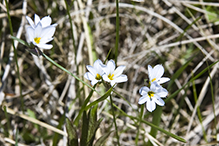 |
|
Inflorescence |
||

Slideshows |
|

Visitor Videos |
||
Share your video of this plant. |
||
This button not working for you? |
||
|
Other Videos |
||
|

Visitor Sightings |
||
Report a sighting of this plant. |
||
This button not working for you? |
||
| Nancy Falkum 6/16/2022 |
Location: Weaver Dunes Preserve, Cox Unit Blue-eyed Grass at TNC Cox Unit |
 |
| Nancy Falkum 5/27/2022 |
Location: Kellogg Weaver Dunes SNA, Weaver Dunes Unit |
 |
| Nancy Falkum 5/21/2022 |
Location: Kellogg Weaver Dunes SNA, Weaver Dunes Unit |
 |
| Nancy Falkum 6/23/2021 |
Location: Kellogg Weaver Dunes SNA, Weaver Dunes Unit Blue-Eye Grass |
 |
| Bill Reynolds 6/14/2014 |
Location: Pennington County |
 |
MinnesotaSeasons.com Sightings |
||

|
Created: Last Updated: © MinnesotaSeasons.com. All rights reserved. |
